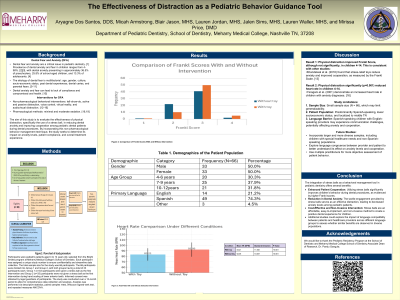Patient Management
20 - The Effectiveness of Distraction as a Pediatric Behavior Guidance Tool


Aryagne H. Dos Santos Pereira, DDS (she/her/hers)
Resident
Meharry Medical College School of Dentistry
Meharry Medical College School of Dentistry
Nahsville, Tennessee, United States- MP
Mirissa Price, DMD
Meharry Medical College
Nashville, Tennessee, United States
Presenting Author(s)
Program Director(s)
Purpose: Pediatric dental anxiety can result in treatment avoidance, compromised oral health, and increased challenges for dental professionals. Non-pharmacological behavior guidance techniques, including physical distraction, offer cost-effective and low-risk interventions to manage patient anxiety. The aim of this mixed-methods clinical study is to evaluate the impact of physical distraction, specifically therapeutic toys/stress balls, on managing pediatric anxiety in the dental setting.
Methods: Participants (n=66) aged 4 to 14 received hand-scaling of anterior teeth both with and without the stress ball intervention. Patients were randomly assigned to groups such that half of patients received the stress ball as the first intervention, and half received the control of no stress ball as the first intervention. Tell-show-do was used, as well, for all patients and groups. Heart rate and Frankl score were reported by calibrated examiners.
Results: A majority of patients (92%) had parent-reported dental anxiety, with 1 patient also having a diagnosis of ADHD and 4 having a dual-parent-reported diagnosis of Autism Spectrum Disorder. 50% of patients were female, and 49% spoke Spanish as a primary language. 97% of patients had a high Caries Risk Assessment (CRA) with only 2 patients having a Moderate CRA. Paired Samples T-Test showed use of the stress ball had a large effect (d=5.3, P< .05) on heart rate and medium effect (d=0.52, P< 0.05) on Frankl score.
Conclusion: Use of a stress ball in combination with tell-show-do results in significant reduction in heart rate and improvement in Frankl score for pediatric patients in the dental setting.
Identify Supporting Agency and Grant Number:

.jpg)